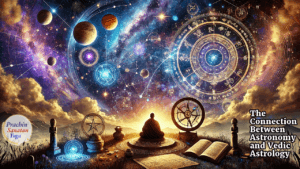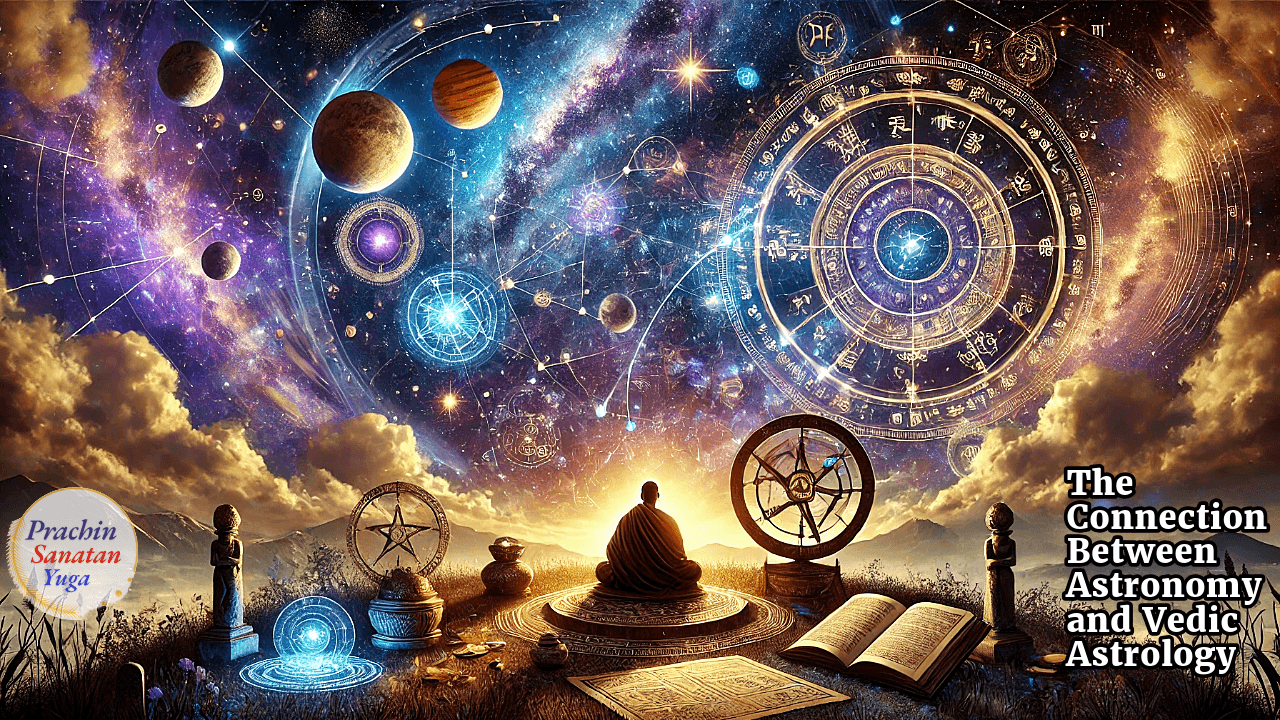
The Connection Between Astronomy and Vedic Astrology
Connection Between Astronomy and Astrology
The relationship between astronomy and Vedic astrology is deeply rooted in ancient Indian traditions, blending scientific observations with metaphysical interpretations. While the scientific study of celestial objects and their motions is conducted by astronomy, Vedic astrology (Jyotish Shastra) applies this knowledge to interpret the influence of cosmic phenomena on human life and destiny. This knowledge is then used to interpret the influence of cosmic phenomena on human life and destiny. This intersection of science and spirituality forms the foundation of Vedic thought, emphasizing the interconnectedness of the universe.
“Astronomy in Vedic Tradition”
Astronomy, or Jyotisha, in the Vedic context, is one of the six Vedangas (limbs of the Vedas) that guide ritualistic practices. The sages of ancient India meticulously observed the sky to understand the movements of the sun, moon, planets, and stars. These observations were used to calculate time (muhurta), determine auspicious dates (muhurta nirnaya), and guide agricultural activities.
The depth of ancient Indian knowledge is revealed by key astronomical texts like the Surya Siddhanta and Aryabhatiya. Precise calculations of planetary orbits, eclipses, and solstices are provided, demonstrating a sophisticated understanding of the cosmos.
“Astrology: Applying Astronomy to Human Life”
The interpretive arm of this celestial knowledge is seen in Vedic astrology. The positions of planets and constellations at the time of a person’s birth are viewed as a cosmic map that influences their personality, behavior, and life events. This practice is based on the belief that the universe is an interconnected entity, where celestial movements reflect the subtle energies affecting human life.
Astrological charts, or kundalis, are created using astronomical data. The twelve zodiac signs (rashi), the 27 lunar mansions (nakshatras), and planetary transits are all calculated using precise astronomical principles.
“Key Connections Between Astronomy and Vedic Astrology”
Zodiac System:
The zodiac in Vedic astrology is based on the sidereal system, which accounts for the precession of the equinoxes. Astronomical calculations determine the positions of the 12 signs, ensuring alignment with the fixed constellations.
Planetary Movements:
Astronomers track the orbits of planets around the Sun, while astrologers interpret their positions relative to the Earth. For instance, retrograde motion, an apparent reversal of a planet’s path, has specific astrological implications, such as delays or introspection.
Eclipses:
Astronomically, the Sun, Moon, and Earth align to cause eclipses. In astrology, people consider eclipses as powerful celestial events that have the potential to trigger significant changes or upheavals. These events hold great importance in both scientific and astrological communities.
Lunar Mansions (Nakshatras):
Ancient astronomers divided the sky into 27 nakshatras, each spanning 13°20′. These play a critical role in Vedic astrology, influencing a person’s mental and emotional tendencies.
Timekeeping:
The Panchang (Vedic almanac) is a blend of astronomical precision and astrological insight, with celestial data used to provide information on tithis (lunar days), nakshatras, and planetary transits to guide daily activities and rituals. This information is used to guide daily activities and rituals, with celestial data providing details on tithis (lunar days), nakshatras, and planetary transits.
Table of Contents
“Scientific Basis and Spiritual Insights”
While astrology is dismissed by modern astronomy as non-scientific, a common foundation in celestial observation is shared by the two. Ancient Indian astronomers such as Aryabhata, Varahamihira, and Bhaskara II were not only mathematicians but also astrologers, with the dual importance of precise calculations and metaphysical interpretations emphasized by them.
“A spiritual dimension is added to astronomy by astrology, encouraging humans to be viewed as part of a larger cosmic order. Harmony with nature is promoted by this perspective, aligning personal actions with celestial rhythms.”
Modern Relevance
Today, while astronomy is primarily a scientific pursuit, Vedic astrology continues to resonate with millions. People consult astrologers for insights into their careers, relationships, and spiritual paths. Interestingly, many modern astrologers use astronomical software to ensure accurate planetary positions, highlighting the enduring connection between these disciplines.
In general, it can be said that,
The holistic worldview of ancient Indian sages is reflected by the synergy between astronomy and Vedic astrology. The factual framework of celestial movements is provided by astronomy, while astrology is imbued with meaning, connecting human existence to the cosmos. Together, they remind us of the intricate balance between science and spirituality and invite us to explore the universe not only as observers but also as participants in its grand design.
For a deeper dive into such topics, explore more at Prachin Sanatan Yuga.
Connection Between Astronomy and Astrology Connection Between Astronomy and Astrology Connection Between Astronomy and Astrology Connection Between Astronomy and Astrology Connection Between Astronomy and Astrology Connection Between Astronomy and Astrology
